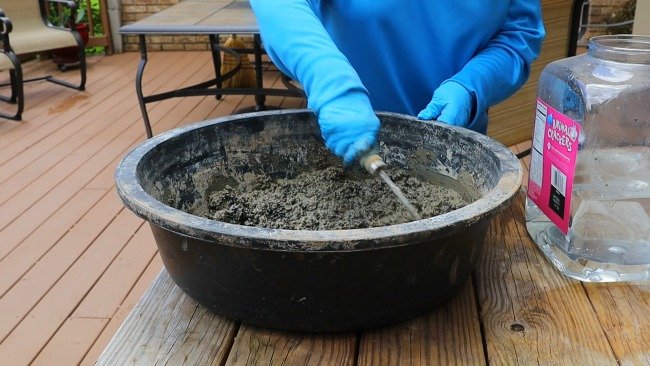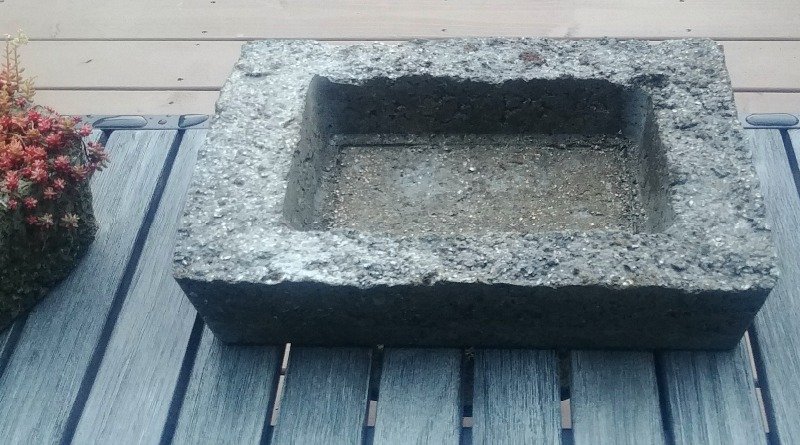Trying To Make Foaming Hypertufa – You’ve Heard of AirCrete? – Will It Work? FAIL!
I have attempted an experiment for a different variation of hypertufa. I know we make hypertufa for a lighter version of concrete planters, so having recently read about foaming concrete or AirCrete, I thought why not try this and make foaming hypertufa too?
By the time I put out this post, I hope I will have a foaming hypertufa planter ( don’t have a name for it but I’ll call it AirTufa,) of some size but I won’t know how it will behave over time, so if you like the idea you may want to experiment with me.

Using the instructions for making foaming concrete that I found elsewhere on the Internet, I am just adapting that recipe for my AirTufa or foaming hypertufa. I will add Dawn Dish detergent as my foaming agent and see how that performs. Then I will see if I feel the results give me reason to believe that I need to decrease/increase the peat moss or coir, or alter the amount of vermiculite that I put in the original recipe.
It was an epic fail – My Method for Making Foaming Hypertufa
Using a large bucket ( I say something deep like this since you will be mixing it with a drill attachment), just do the regular routine of mixing all dry ingredients first. For my first experiment, I am mixing with my regular ratio of 1 part Portland cement, 1 part sifted peat moss, and 1 part vermiculite. I am making a small pot for my succulents to begin with since I don’t want to waste a lot of ingredients if it should not, from the get go, set up properly.

Also I am not sure how fluid it will be (and it ended up not being to much different than regular hypertufa mix) and I will have to have something that I can set another form inside the original form since I don’t think it will be “packing” like my regular hypertufa recipe mix. But we shall see.
I have collection of plastic boxes that I got at a Thrift Store for a few dollars! What a find! And so colorful for the videos too! I like to make hypertufa planters inside, so I will be matching up a couple to get the right fit for my sides on the planter to be thick enough.

My plan would be to put one box inside of the other, both sprayed with baking oil. It should make a great trough for succulents like the ones I got in a recent plant haul. Love making those videos. Check it out!

Drexel is the true foaming agent for AirCrete , (#affiliate link) plus a machine that creates the foam, but I decided not to buy it since the only sizes I found were large and expensive. According to that cited article, it is just a detergent-based liquid but we can substitute Dawn Dish Detergent or Axion, whatever you have available. This may need some stretch to experiment. I am assuming that we a needing a strong detergent and one that makes lots of bubbles since we are looking to “bubble up” the hypertufa mix.
Now I Have To Work Up The Amounts!
The ratio of the detergent to water is 1 to 40 which is approximately 2 cups Dawn to 5 gallons of water. I won’t be making this big of a batch for my first try so I will start with a much smaller amount.

So with that formula, 2 cups Dawn is 16 ounces, 5 gallons water is 640 ounces
Ratio in ounces is 16 oz to 640 oz
If I only need, for instance, 1 gallon of water for my first recipe, I will use 3.2 oz of Dawn to 128 oz or 1 gallon of water.
Mixing Up the Recipe for Foaming Hypertufa
After choosing the amount of water that I felt we might need, we mixed the Dawn or Suave Shampoo and water together and here is where the deep bucket came in handy. I used a long paint/mortar mixer attachment for drill .
I am including an Amazon affiliate link to this piece so that you can see what it is, but you may find it at your local Lowe’s or Home Depot or paint store. Maybe you already have one?
Here is where the “foaming” takes place. We will mix the Dawn ( or Suave) and water together and use the drill extension to foam it up. We will get this all foamy looking for a texture like shaving cream. Then this will be folded into the hypertufa mixture.
So basically we will be adding the foamy mix into your hypertufa mixture just like you have always made it. Now pack into your form. I think it needs an inner liner so that is how I have planned for mine to be constructed. I am allowing at least a 1 inch side and bottom because I want it thick enough.
How did it turn out? It was a Fail!
I could not whip the foaming agent ( I used Dawn) into a lasting foam. It whipped up nicely but within an hour or so, the bubbles were all collapsed and dead. No strong mixture of “foam” to make an airy mix of hypertufa. I mixed and mixed again and again with stronger and stronger solutions. FAIL. I finally gave up and said
“If you want a strong bubbly mix like Shaving Cream, then I’ll just use shaving cream and be done with this great experiment.”

How Did It Go With Shaving Cream?
It smelled good.
Yes, that was about it. I mixed it up, packed it, and let it set and cure just like regular hypertufa. But I could find no difference in the weight or density. Perhaps it seemed to be packed slightly “tighter” for lack of a better word. But there is no way I would even remotely consider this like an Air Crete version of hypertufa.
Perhaps I failed in not buying the “real thing.” There is a mix called Drexel, a foaming agent that is used to spray on crops in the field which holds foam for a day or so. It is the vehicle that makes the insecticide or treatment of whatever kind stick to the plant for a while, meaning it needs to stay in a foam condition for up to 24 hours. There was no way I could make any such thing. Not with my capabilities.
I had no AirCrete machine gun to shoot the Drexel and I wasn’t even going to attempt to build anything like it. Guess I was just not committed to the project.
What Was My Result?
My result was a typical hypertufa trough that I plan to use for Sempervivum or Baby’s Tears. I have made it very shallow so that it would be just for plants with short roots. Or at least I hope that is how it will work. Maybe I could put some moss in it?

I do think that the texture is somewhat more visibly porous. It seems that the bubbles in the mix did make a more uniform appearance to the texture. I may try this again with wither the real foaming agent if I decide to buy some. or the shampoo version (Suave). Perhaps my hub will rig up something so that I can have something in combination with the air compressor that he already has?

I don’t notice any “lighter” weight to the foaming hypertufa trough. If it is lighter, it is not noticeable by me when lifting. As is ages this summer, I will see if it is the same in lasting for a lengthy time, durable, not crumbly. Here’s hoping I get something that I was looking for, even if it is not truly Airtufa!



After doing some short research of my own, I’m not sure using AirCrete would have many benefits for hypertufa-type containers. It appears to have good insulation properties but not the strength required for larger containers. Would still have to reinforce.
I can’t wait to hear how yours holds up, Kim. No experiment is a true fail if you learn something from it!
Nancy
I’ve never made hypertufa (yet), so I don’t know if this would work, but if you already had foam created, could it perhaps be folded in, the way we gently merge whipped egg whites into batter?
For a small project, what if you first ran the Dawn or other soapy ingredient through an aerating dispenser like those that foaming soaps come in?
This way, the agitation that creates the foam wouldn’t simultaneously be deflating it.
I don’t know how much play you have, but in a thinner “batter”, foam is more stable to begin with. And it can be folded in with less agitation.
Sounds like it would make a good experiment. Let us know what happens.